2. 上海海洋大学 港航生态安全研究中心, 上海 201306
长江口是中国最大的江河入海口,生物多样性丰富[1]。底栖动物是河口生态系统的重要组成部分,对河口栖息地的生态过程有着重要的影响[1]。我国自20世纪50年代末开始对长江口底栖生物的种类组成[2-3]、群落结构[3-5]和次级生产力[4]等方面开展了许多工作,由于受崇明岛的分隔,长江口分成南北两支,长江径流主要从南支入海,因而以往有关长江口底栖动物的研究重点更关注长江口南支和口外海域[4-13],对北支底栖动物的研究则较少[5]。长江口北支崇明岛一侧,滩涂面积广泛,以北八滧河为界,河东为崇明东滩鸟类自然保护区和长江口中华鲟湿地自然保护区,此地不仅仅是迁徙候鸟重要的栖息地和中转站,也是珍稀鱼类中华鲟繁殖育幼的场所[14]。河西有约160 km2的潮间带滩涂,近年来部分滩涂开展了贝类养殖,主要养殖缢蛏(Sinonovacula constricta)、彩虹明樱蛤(Moerella iridescens)和泥螺(Bullacta exarata)等大型底栖贝类,这些贝类也是该滩涂的土著栖息种类。自2010年起每3年在此地放流一次大型底栖贝类,进行生态和渔业资源修复,每次投放泥螺1 000 t、彩虹明樱蛤2 000 t以及缢蛏5 000 t进行生态修复。在放流前曾对北支滩涂潮下带大型底栖动物进行过调查[15],在放流1年后开展本次调查,以评估滩涂贝类资源修复对邻近潮下带大型底栖动物的影响,并为长江口鸟类和鱼类的保护以及滩涂湿地生态修复提供理论基础。
1 材料与方法 1.1 站位的选择和样品采集方法2012年9月(秋季)、12月(冬季)和2013年3月(春季)、6月(夏季)在长江口北支崇明北水闸至黄瓜沙(31°37.008′N, 121°46.633′E—31°769′N, 121°50.733′E)滩涂潮下带设置5个采样站点(图 1),分别为S1、S2、S3、S4和S5。依据《海洋调查规范GB 17378.7—2007》[16]每月进行大型底栖动物拖网采集,采样拖网采用0.5 cm阿氏拖网,拖网时间10~15 min,船速2 kn。拖网完成后,将网内生物过0.5 mm筛网进行初步分拣。为防止沙蚕头部收缩,可用少量乙醇麻醉5 min后再加入1%福尔马林溶液固定,其余样品固定在福尔马林溶液里,带回实验室鉴定。
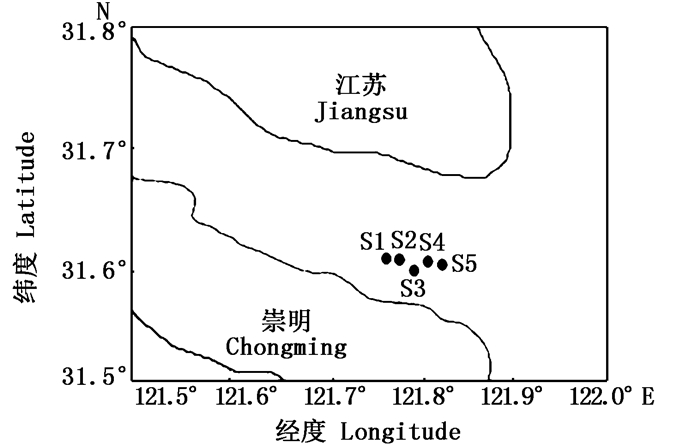
|
图 1 长江口北支海域大型底栖生物采样站位图 Fig. 1 Bitmap of large benthic sampling stations in the north branch of the Yangtze River Estuary |
数据分析均在R 2.15.1 [17]中进行,使用VEGAN程序包计算长江口大型底栖动物群聚的丰富度指数(D)、香农-威纳指数(H′)、均匀度指数(J),利用长江口北支5个样点的密度和环境因子进行RDA分析。其他数据参考公式如下:物种优势度指数(Y)
 (1)
(1)
式中:N表示各采样点所有物种个体总数;ni代表第i种的个体总数;fi表示该物种在各个采样点出现的频率,当Y > 0.02时,该物种为群落中的优势种。
2 结果分析 2.1 种类组成共采集到大型底栖动物51种(表 1),其中环节动物4种,占比7.8%;软体动物15种,占比29.4%;节肢动物17种,占比33.3%;鱼类14种,占比27.5%;纽形动物1种,占比1.9%。调查显示该片海域大型底栖动物组成以软体动物、节肢动物的甲壳动物和鱼类为主。

|
表 1 长江口北支大型底栖生物的种类组成 Tab.1 Species composition of macrobenthos in the northern branch of the Yangtze River Estuary |
优势种共有8种,分别为泥螺(Bullacta exarata,Y=0.05)、黑龙江河篮蛤(Potamocorbula amurensis,Y=0.131)、安氏白虾(Exopalaemon annandalei,Y=0.031)、脊尾白虾(Exopalaemon carinicauda,Y=0.042)、狭颚新绒螯蟹(Neoeriocheir leptognathus,Y=0.028)、豆形拳蟹(Philyra pisum,Y=0.026)、鲬(Platycephalus indicus,Y=0.027)和棘头梅童鱼(Collichthys lucidus,Y=0.074)。
2.2 数量变化调查期间,大型底栖动物四季平均密度为0.265个/m2,具有明显的季节变化,夏季最高,达0.71个/m2,其他3季密度相近,为0.10~0.14个/m2,相差约5~7倍(图 2)。同一季节,不同类群的底栖动物密度不同,秋季底栖动物密度为0.11个/m2,其中软体动物33.9%、鱼类33.9%、甲壳动物32.2%;冬季密度为0.10个/m2,其中甲壳动物78.8%、软体动物14.1%、鱼类4.8%、环节动物2.3%;春季密度为0.14个/m2,其中软体动物70.2%、甲壳动物20%、环节动物7.9%、鱼类1.9%;夏季为0.71个/m2,其中鱼类52.1%、软体动物32.4%、甲壳动物11.12%、环节动物4.2%、纽形动物0.58%。
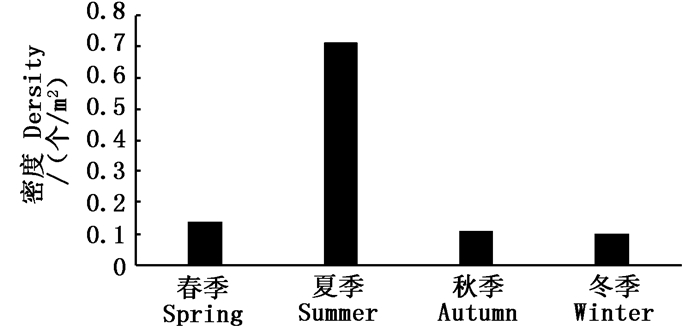
|
图 2 长江口北支大型底栖动物密度的季节变化 Fig. 2 Seasonal variation of macrobenthos density in the northern branch of the Yangtze River Estuary |
大型底栖生物平均生物量为0.06 g/m2,随季节变化明显,春季最高,达0.14 g/m2,其他3个季节生物量相差较大,在0.03~0.11 g/m2之间,相差约3.6倍(图 3)。同一季节,不同类群的底栖动物生物量不同。秋季为0.03 g/m2,其中脊索动物47.60%、节肢动物27.68%、软体动物24.67%、环节动物0.05%;冬季为0.11 g/m2,其中节肢动物84.88%、脊索动物13.07%、软体动物2.04%、环节动物0.01%;春季(2013年3月)为0.14 g/m2,其中软体动物86.92%、节肢动物10.10%、脊索动物2.85%、环节动物0.13%;夏季(2013年6月)为0.07g/m2,其中脊索动物49.57%、节肢动物39.23%、软体动物9.22%、环节动物1.85%、纽形动物0.13%。
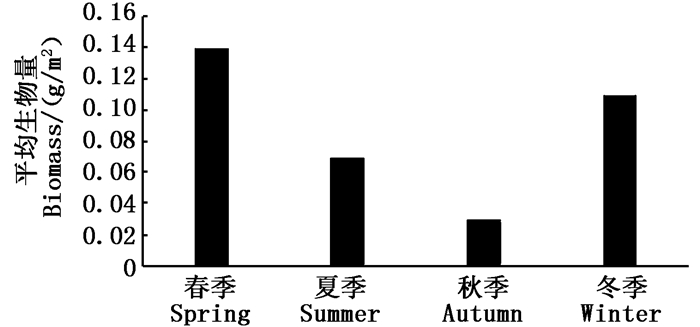
|
图 3 长江口北支大型底栖生物生物量的季节变化 Fig. 3 Seasonal variation of biomass of macrobenthos in the northern branch of the Yangtze River Estuary |
香农-威纳指数随季节变化明显,夏季最高,达2.02,生物多样性丰富。其他季节相近,在1.02~1.45之间(图 4)。
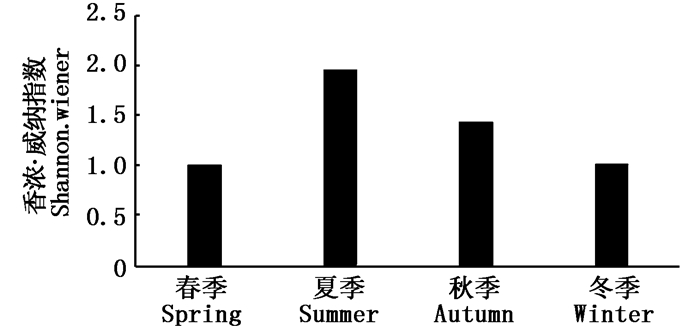
|
图 4 长江口北支大型底栖生物各季节香农-威纳指数 Fig. 4 Seasonal Shannon-Weiner index of macrobenthos in the northern branch of the Yangtze River Estuary |
丰富度指数随季节变化明显,夏季最高,达1.31。其他季节相近,在0.57~0.64之间(图 5)。

|
图 5 长江口北支大型底栖生物各季节丰富度指数 Fig. 5 Seasonal Margalef index of macrobenthos in the northern branch of the Yangtze River Estuary |
均匀度指数随季节变化明显,秋季最高,达0.46。其他季节相近,在0.40~0.44之间(图 6)。
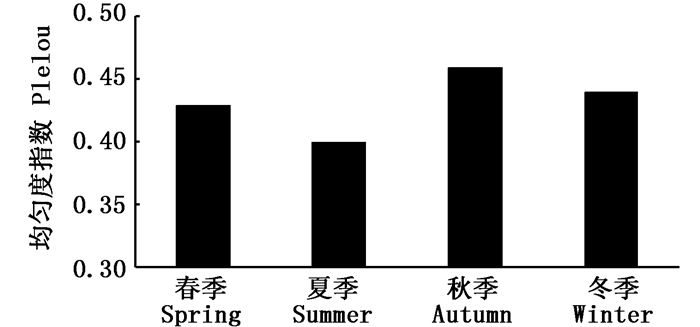
|
图 6 长江口北支大型底栖生物各季节均匀度指数 Fig. 6 Seasonal Pielou index of macrobenthos in the northern branch of the Yangtze River Estuary |
本次调查共采集到大型底栖动物51种,低于2010—2011年调查[15]到的78种,而且种群结构变化较大,相较于第1次调查,新采集到11个种,但第1次调查采集到的种类中有38个种在本次调查中未被采集到。这可能是受调查频率影响,第1次周年调查每月1次[15],而本次调查则是每季度1次,采样次数减少,导致密度低的偶见种没有被采集到[15]。本次调查与第1次调查都采集到优势种8种,但只有黑龙江河篮蛤1种相同,显示前后两次调查优势种群落发生了显著变化。泥螺成为优势种,可能与贝类放流具有密切关系,在放流的3种贝类中,彩虹明樱蛤和螠蛏是埋栖种类,泥螺则为底表匍匐种类,相比运动能力较强,因而可能有一部分从放流区移动到采样区,成为该水域的优势种。比较两次的其他7个优势种发现,运动能力强的种类增加,这些种类可以随着涨潮运动到达潮间带放流区,从而获得丰富的饵料。孙亚伟等[13]、叶属峰等[18]、刘录三等[19]和徐兆礼等[20]对长江口大型底栖动物的研究显示,从2009年开始长江口大型底栖动物的总体密度均值和生物量呈现下降趋势,小型且移动能力灵活的个体逐渐成为优势种,本次研究也显现了类似的规律。因而,贝类的放流会影响放流区邻近海域底栖动物的组成和群落结构。此外,第2次周年调查群落及优势种的变化,可能还受到水环境年度变化的影响[21]。该海域邻近上海崇明东滩鸟类自然保护区和长江口中华鲟湿地自然保护区,贝类放流和底栖动物群落的变化,是否会对鸟类和中华鲟产生相应影响,需要开展进一步的研究。
| [1] |
刘志权.崇明东滩大型底栖动物对人类活动的响应及生态修复研究[D].上海: 华东师范大学, 2017. LIU Z Q. Response of macrobenthos on human activities and the ecological restoration in east shoal of Chongming island[D]. Shanghai: East China Normal University, 2017. http://cdmd.cnki.com.cn/Article/CDMD-10269-1017098503.htm |
| [2] |
严娟, 庄平, 侯俊利, 等. 长江口潮间带大型底栖动物次级生产力及其影响因子[J]. 应用与环境生物学报, 2012, 18(6): 935-942. YAN J, ZHUANG P, HOU J L, et al. Secondary production of macrobenthos from intertidal in the Changjiang estuary and its impact factors[J]. Chinese Journal of Applied and Environmental Biology, 2012, 18(6): 935-942. |
| [3] |
李宝泉, 李新正, 王洪法, 等. 长江口附近海域大型底栖动物群落特征[J]. 动物学报, 2007, 53(1): 76-82. LI B Q, LI X Z, WANG H F, et al. Characters of a macrobenthic community off the Changjiang River Estuary[J]. Acta Zoologica Sinica, 2007, 53(1): 76-82. |
| [4] |
章飞军, 童春富, 张衡, 等. 长江口潮下带春季大型底栖动物的群落结构[J]. 动物学研究, 2007, 28(1): 47-52. ZHANG F J, TONG C F, ZHANG H, et al. Community structure of macrobenthic fauna in subtidal areas of the Yangtze River Estuary in spring[J]. Zoological Research, 2007, 28(1): 47-52. DOI:10.3321/j.issn:0254-5853.2007.01.008 |
| [5] |
罗民波, 沈新强, 徐兆礼, 等. 长江口北支水域潮间带大型底栖动物研究[J]. 海洋环境科学, 2006, 25(4): 43-47. LUO M B, SHEN X Q, XU Z L, et al. Study on intertidal macrobenthos in North Branch of Changjiang Estuary[J]. Marine Environmental Science, 2006, 25(4): 43-47. DOI:10.3969/j.issn.1007-6336.2006.04.012 |
| [6] |
寿鹿, 曾江宁, 廖一波, 等. 瓯江口海域大型底栖动物分布及其与环境的关系[J]. 应用生态学报, 2009, 20(8): 1958-1964. SHOU L, ZENG J N, LIAO Y B, et al. Seasonal distribution of macrozoobenthos and its relations to environmental factors in Oujiang River Estuary sea area[J]. Chinese Journal of Applied Ecology, 2009, 20(8): 1958-1964. |
| [7] |
安传光, 赵云龙, 林凌, 等. 长江口九段沙潮间带大型底栖动物季节分布特征的初步研究[J]. 水产学报, 2007, 31(s1): 52-58. AN C G, ZHAO Y L, LIN L, et al. Primary investigation of seasonal characters of macrobenthic communities distribution in tidal flats of Jiuduansha wetland of Yangtze River Estuary[J]. Journal of Fisheries of China, 2007, 31(s1): 52-58. |
| [8] |
彭松耀, 赖子尼, 蒋万祥, 等. 珠江口大型底栖动物的群落结构及影响因子研究[J]. 水生生物学报, 2010, 34(6): 1179-1188. PENG S Y, LAI Z N, JIANG W X, et al. Study on community structure of macrozoobenthos and impact factors in Pearl River estuary[J]. Acta Hydrobiologica Sinica, 2010, 34(6): 1179-1188. |
| [9] |
张敬怀, 高阳, 方宏达, 等. 珠江口大型底栖生物群落生态特征[J]. 生态学报, 2009, 29(6): 2989-2999. ZHANG J H, GAO Y, FANG H D, et al. Ecological characteristics of macrobenthic communities in Pearl River Estuary[J]. Acta Ecologica Sinica, 2009, 29(6): 2989-2999. DOI:10.3321/j.issn:1000-0933.2009.06.027 |
| [10] |
赵永强, 曾江宁, 陈全震, 等. 椒江口潮间带大型底栖动物群落beta多样性分析[J]. 海洋学报, 2009, 31(3): 103-112. ZHAO Y Q, ZENG J N, CHEN Q Z, et al. Beta-diversity analysis of macrozoobenthos community in a tide flat in the Jiaojiang Estuary in Zhejiang Province, China[J]. Acta Oceanologica Sinica, 2009, 31(3): 103-112. DOI:10.3321/j.issn:0253-4193.2009.03.012 |
| [11] |
田伟, 徐兆礼, 周进, 等. 椒江口海域大型底栖动物群落结构的研究[J]. 复旦学报(自然科学版), 2013, 52(2): 271-277. TIAN W, XU Z L, ZHOU J, et al. The study on macrobenthos community structure in Jiaojiang Estuary[J]. Journal of Fudan University (Natural Science), 2013, 52(2): 271-277. |
| [12] |
吴耀泉, 李新正.长江口区底栖生物群落多样性特征[C]//甲壳动物学论文集.青岛: 中国动物学会, 2003: 281-288. WU Y Q, LI X Z. Diversity of benthos community in Changjiang Estuary[C]//Proceedings of Crustaceans. Qingdao: China Zoological Society, 2003: 281-288. http://cpfd.cnki.com.cn/Article/CPFDTOTAL-ZGDX200211001098.htm |
| [13] |
孙亚伟, 曹恋, 秦玉涛, 等. 长江口邻近海域大型底栖生物群落结构分析[J]. 海洋通报, 2007, 26(2): 66-70. SUN Y W, CAO M, QIN Y T, et al. Analysis of macrobenthos community structure in the adjacent sea area of Changjiang River eastuary[J]. Marine Science Bulletin, 2007, 26(2): 66-70. DOI:10.3969/j.issn.1001-6392.2007.02.010 |
| [14] |
王春峰, 陈锦辉, 黄硕琳, 等. 长江口中华鲟保护区生态环境初步评价[J]. 上海海洋大学学报, 2010, 19(5): 674-678. WANG C F, CHENG J H, HAUNG S L, et al. Preliminary evaluation of Yangtze Estuarine nature reserve for Chinese Sturgeon[J]. Journal of Shanghai Ocean University, 2010, 19(5): 674-678. |
| [15] |
赵开彬, 刘婧, 吴惠仙, 等. 长江口北支大型底栖动物群落周年变化特征[J]. 生物学杂志, 2014, 31(3): 1-6. ZHAO K B, LIU J, WU H X, et al. Anniversary variation characteristics of benthic animal community in the north branch of the Yangtze River Estuary[J]. Journal of Biology, 2014, 31(3): 1-6. |
| [16] |
中华人民共和国国家质量监督检验检疫总局, 中国国家标准化管理委员会. GB 17378.7-2007海洋监测规范第7部分: 近海污染生态调查和生物监测[S].北京: 中国标准出版社, 2008. General Administration of Quality Supervision, Inspection and Quarantine of the People's Republic of China, Standardization Administration of China. GB 17378.7-2007 The specification for marine monitoring-Part 7: Ecological survey for offshore pollution and biological monitoring[S]. Beijing: Standards Press of China, 2008. |
| [17] |
赖江山, 米湘成.基于Vegan软件包的生态学数据排序分析[C]//第九届全国生物多样性保护与持续利用研讨会论文集.厦门: 国际生物多样性计划中国委员会, 中国科学院生命科学与生物技术局, 2010: 332-343. LAI J S, MI X C. Ordination analysis of ecological data using vegan in[C]//Proceedings of the 9th National Symposium on Biodiversity Conservation and Sustainable Use. Xiamen, 2010: 332-343. http://www.wanfangdata.com.cn/details/detail.do?_type=conference&id=8492271 |
| [18] |
叶属峰, 纪焕红, 曹恋, 等. 河口大型工程对长江河口底栖动物种类组成及生物量的影响研究[J]. 海洋通报, 2004, 23(4): 32-37. YE S F, JI H H, CAO L, et al. Studies on the impacts of large-scale estuarine engineering on species composition and biomass of benthos in the Yangtze River Estuary[J]. Marine Science Bulletin, 2004, 23(4): 32-37. DOI:10.3969/j.issn.1001-6392.2004.04.006 |
| [19] |
刘录三, 郑丙辉, 李宝泉, 等. 长江口大型底栖动物群落的演变过程及原因探讨[J]. 海洋学报, 2012, 34(3): 134-145. LIU L S, ZHENG B H, LI B Q, et al. Long-term trends of macrobenthos in Changjiang Estuary, China in relation to environmental changes[J]. Acta Oceanologica Sinica, 2012, 34(3): 134-145. |
| [20] |
徐兆礼, 蒋玫, 白雪梅, 等. 长江口底栖动物生态研究[J]. 中国水产科学, 1999, 6(5): 59-62. XU Z L, JIANG M, BAI X M, et al. An ecological study on benthos in the Changjiang Estuary[J]. Journal of Fishery Sciences of China, 1999, 6(5): 59-62. |
| [21] |
贾海波, 胡颢琰, 唐静亮. 舟山群岛夏季潮间带大型底栖生物群落生态学研究[J]. 中国环境监测, 2013, 29(4): 64-68. JIA H B, HU H Y, TANG J L. The summertime ecological study of the macrobenthic community in intertidal zone of Zhoushan Archipelago[J]. Environmental Monitoring in China, 2013, 29(4): 64-68. DOI:10.3969/j.issn.1002-6002.2013.04.014 |
2. Center for Research on the Ecological Security of Port and Shippig, Shanghai Ocean University, Shanghai 201306, China
 2019,
Vol. 28
2019,
Vol. 28


